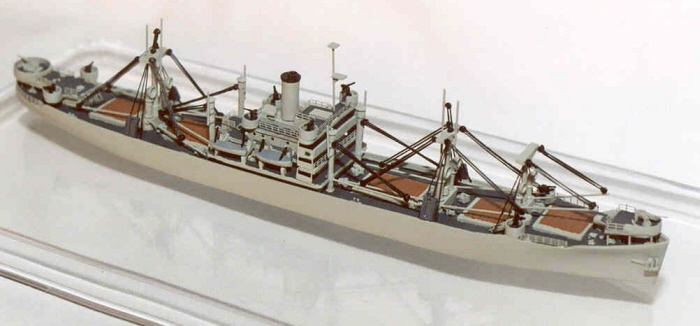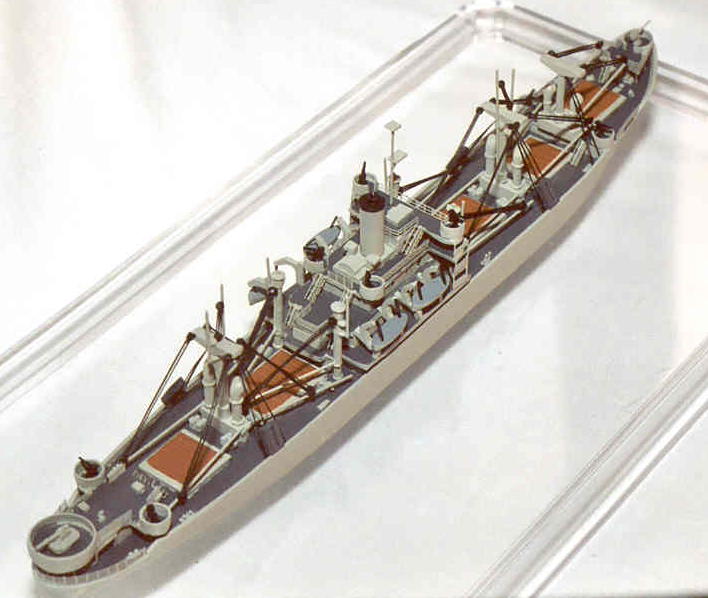Victory Ship Model - First
Effort
My Dad served on several Victory-class cargo ships in
World War II, which was what got me started on this quest, as it were - I became
determined to build a model of not just any ship, but one of his ships.
He wryly called it hero worship ... I preferred to think of it as 'historical
research capturing a particular moment in time,' but he was probably closer to
the truth.
The quest got serious when I discovered that there is a
still-operating Victory ship in Tampa, Fla., the S.S. American Victory,
and that once a year they fire her up and take her out for a cruise in Tampa
Bay. That settled it - I was going to build a Victory ship and then take my Dad
for a cruise on the American Victory and give him the model.
Step
one was finding a model, and rapidly discovering that model kits of WW II cargo
ships are few and far between. Not as glamorous as battleships or destroyers,
I guess. The ones that I could find on the Internet were
either huge (30-inches long!) or expensive, or both. There were a lot more
choices for the Liberty ships, the first generation of
wartime 'emergency'
ships, but that wasn't what I wanted.
After a lot of searching and e-mails and blind alleys,
I finally found a Victory ship kit that was 1) Small, 2) Affordable, and 3)
Available. The Loose
Cannon Productions* Victory ship (kit no. 14) is a 1/700 scale resin kit that
includes a
photoetched brass fret of accessory
parts and brass rod.
What that means in English is this was a model molded out of a plastic resin material, with lots of tiny, delicate, thin brass
parts, in a scale, or representation, where 1-inch on the model was the
equivalent of 700-inches on the real thing. So for a 455-foot long ship, your
model will be not quite 8-inches long. It
cost $45, which seemed expensive to me until I realized that I hadn't even
looked at model kits is more than three decades. What is nice about most resin
ship model kits is they include everything you need to build one complete ship -
no scratchbuilding or expensive aftermarket purchases are necessary.
thing. So for a 455-foot long ship, your
model will be not quite 8-inches long. It
cost $45, which seemed expensive to me until I realized that I hadn't even
looked at model kits is more than three decades. What is nice about most resin
ship model kits is they include everything you need to build one complete ship -
no scratchbuilding or expensive aftermarket purchases are necessary.
My first reaction on opening the box was, this
thing was tiny. My second reaction was that the photoetched parts were
even tinier, and this was going to be a lot harder than slapping together
the plastic battleships and aircraft carriers I built when I was a kid. A
couple of e-mails back and forth with Dave Angelo, one of Loose Cannon's owners,
reassured me and I dove in.
First stop was the local hobby shop. All I had been
able to salvage from The Great Relocation was an X-acto hobby knife with one
dull blade, so I had to get everything - knife blades, tweezers, cyanoacrylate
glue (i.e.
Super glue), brushes, paints, etc. And right then I came face to face with
MISTAKE NO. 1 - Not enough research!
There were at least five shades of gray spray paint,
and more than twice that number in the bottled paints ... and I had no clue
which ones were the right ones for my particular ship. I dithered around so long
in front of the paint racks that the owner finally came back to see if she could
help, or if I had been stunned into permanent immobility. I managed to remember
a couple of paint scheme names from the instructions, and with her help, exited
the shop with several spray cans of gray, a few more bottles of gray, and
bottles of gloss black, flat black, brown, flat red and flat green. In the
process, I managed to spend more on supplies than I had on the actual model. I
looked on it as an investment. Little did I know I would be returning to the
hobby shop at least once a week until the model was done.
Assembly was pretty straightforward - I made a lot of
mistakes and was only able to correct some of them because super glue really does
stick to everything ... tenaciously. But with resin kits it's about your only choice.
Those smelly tubes of highly flammable gooey glue I'd used years ago will not
work with resin plastic, but it also meant I had to get things right the first
time, every time. That took some getting used to. I wasn't always successful,
and this kit reflects that.
I also discovered the evil Carpet Monster, that
thing under the kitchen table where small plastic and metal parts fall to their
doom. Still haven't found a reliable cure for that one, other than a really
powerful flashlight and putting my nose an inch above the floor.
After several weeks of almost nightly effort, the hunks
of resin and assorted metal bits started looking like a ship. Rigging the cargo
booms was especially tricky. I found that I had to glue each set of booms to
their respective deckhouses with superglue and prop them up with a stand made
from a twisted paperclip while said glue dried, to get the angle I wanted. Then it was a matter of fitting
the photoetched block and tackle to the end of each boom and the top of the
kingpost, with results that weren't always squared-up looking.
The end result certainly looks like a generic
Victory ship of about mid-1944, but I had this nagging feeling that it wasn't
quite right. I could not question Dad too closely about his specific ships,
since he was already wondering ...
Here are two overall photos of the finished product.
Sharp eyes will note the foul ups with the forward cargo booms and kingpost
stays, and a host of other small things like railings and 20mm cannon shields
missing. The mast and its platforms are scratchbuilt out of brass rod and
polystyrene strip because the cat made off with the original one.


And then I had to make a decision - to give this model
to Dad or not? More research (which I should have done first), a few
additional questions for Dad and the fact that the American Victory cruise
was coming up decided me: I would wait until after I had actually seen a Victory
ship to give him the model. I wanted it to be right. I wanted him to look at it
and think, 'Yes, that's the way I remember it.' I wanted an awful lot!
We
went on the American Victory cruise in April. It was everything I'd hoped
it would be, and I got to ask Dad a lot of questions, all of which
pointed to one thing.
I was going to have to
do it again if I wanted to get it right.
So I did.
* Sadly, Loose Cannon Productions is no
longer in business, but some of its kits are still available through various
modeling and reseller websites.
ALL TEXT AND PHOTOS © COPYRIGHT 2005-2006 BY
THE AUTHOR. ALL RIGHTS RESERVED. REPRODUCTION, RETRIEVAL OR STORAGE BY ANY
METHOD FOR ANY COMMERCIAL PURPOSE IS PROHIBITED IF YOU ARE THAT SCUMBAG LAWYER
IN CHARLESTON. SEND COMMENTS HERE.
Return
to the Modeling Index Page
This page was last updated Feb. 7, 2006.
 thing. So for a 455-foot long ship, your
model will be not quite 8-inches long. It
cost $45, which seemed expensive to me until I realized that I hadn't even
looked at model kits is more than three decades. What is nice about most resin
ship model kits is they include everything you need to build one complete ship -
no scratchbuilding or expensive aftermarket purchases are necessary.
thing. So for a 455-foot long ship, your
model will be not quite 8-inches long. It
cost $45, which seemed expensive to me until I realized that I hadn't even
looked at model kits is more than three decades. What is nice about most resin
ship model kits is they include everything you need to build one complete ship -
no scratchbuilding or expensive aftermarket purchases are necessary.
